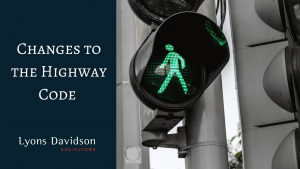
It is perhaps a sign of our times that the changes to the relatively innocuous Highway Code, which came into force on 29th January 2022, have divided opinion and generated sensationalist headlines in the media. Anger levels seem to be rising steadily, and there is even talk (admittedly in the Daily Mail) of “furious motoring groups” beginning a “…fightback in battle of the Highway Code…”.
This response to the changes seems somewhat disproportionate given the proposed changes are for the clear benefit of everybody, and arguably encapsulate what would be regarded by most people as best, safe practice in any event. Hopefully the disquiet will fade once people are educated on the changes, a very brief summary of which is set out below.
Hierarchy of road users
As an overview, Rule H1 of the revised Highway Code introduces a hierarchy of road users and seeks to promote greater protection to vulnerable road users, for example cyclists and pedestrians. The hierarchy that is now in place is as follows (with those road users who are likely to cause most harm appearing at the bottom of the hierarchy):
- Pedestrians
- Cyclists
- Horse riders
- Motorcyclists
- Cars/taxis
- Vans/minibuses
- HGVs
This new hierarchy means that the onus of responsibility now rests with those road users who could cause the greatest harm or injury to other more vulnerable road users. Thus drivers of HGVs, vans and taxis now bear the greatest responsibility to take care and reduce the danger they pose to pedestrians, cyclists and horseriders.
It is worth reminding ourselves that Rule H1 of the Code specifically states: “The objective of the hierarchy is not to give priority to pedestrians, cyclists and horse riders in every situation, but rather to ensure a more mutually respectful and considerate culture of safe and effective road use that benefits all users”. As such all road users have a duty to act respectfully and carefully in order to improve the safety of our roads for all road users.
Changes for the benefit of vulnerable road users
- Pedestrians
Rule H2 provides that if any road user (to include cyclists) is at a junction and turning into a road, the road user must give way to any pedestrians crossing or waiting to cross the road. Previously the road user, and not the pedestrian, had priority in this situation.
Equally if a road user approaches a zebra crossing and there is a pedestrian waiting to cross the road, the pedestrian now has priority. The road user will now have to stop to allow the pedestrian to cross the road. Previously road users were only expected to give priority to pedestrians who were already crossing the road.
Only pedestrians are able to use pavements (pedestrians include wheelchair and mobility scooter users), and cyclists must give way to pedestrians on shared use cycle paths.
- Cyclists and horseriders
Rule H3, which provides for more priority to be given to cyclists, has given rise to much dispute and controversy.
Motorists must now give greater right of way to cyclists when changing lanes or turning at a junction. Motorists specifically must not cut across the path of a cyclist who is travelling straight ahead when undertaking their manoeuvre, and equally must not take any action which could cause the cyclist to have to stop or swerve. The motorist is expected to stop and wait for a safe gap in the traffic to carry out their turn.
The new code also deals generally with road positioning of cyclists, and offers guidance to cyclists to ride in the centre of a lane on quieter roads, in slow moving traffic and at the approach to junctions in order to make themselves as clearly visible as possible. Cyclists are also reminded that they are able to cycle 2 abreast, which can be safer when cycling in large groups or with inexperienced riders or children. Contrary to misleading reports in the media, this is not actually a new rule but simply a reinforcement of the existing rule in place. However cyclists must be aware of other motorists behind them and allow them to overtake when safe to do so.
Stationary motorists are also now encouraged to adopt the “Dutch Reach” when opening their door to ensure the safety of passing pedestrians, cyclists and vehicles. This involves opening the door next to them with their opposite hand and to look over their shoulder before opening the door.
Communication of changes
The changes to the Highway Code make for common sense, and essentially amount to the codification of safe and courteous road use which we should all be adhering to in any event. Furthermore many of the publicised changes, as already referred to above, are no more than a clarification of the existing rules in place.
The government’s THINK! Campaign will shortly launch a communications drive, with the aim of raising awareness of the changes to the Highway Code and ensuring that all road users fully understand their responsibilities. It is hoped that this campaign will ease the unrest caused by the misleading and controversial headlines, and will usefully reinforce to all road users the safe practices that we should be following when using the roads.



